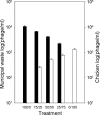Multiplex quantitative real-time reverse transcriptase PCR for F+-specific RNA coliphages: a method for use in microbial source tracking
- PMID: 17142373
- PMCID: PMC1800770
- DOI: 10.1128/AEM.00399-06
Multiplex quantitative real-time reverse transcriptase PCR for F+-specific RNA coliphages: a method for use in microbial source tracking
Abstract
It is well documented that microbial contamination of coastal waters poses a significant risk to human health through recreational exposure and consumption of shellfish. Identifying the source of microbial contamination (microbial source tracking) plays a dominant role in enabling effective management and remediation strategies. One method used to determine the source of the contamination is quantification of the ratio of the four subgroups of F+-specific RNA coliphages (family Leviviridae) in impacted water samples. Because of typically low concentrations in the environment, enrichment assays are performed prior to detection, even though differential replication rates have been reported. These assays are also compromised by differential loss of phage infectivity among subgroups after release into the environment, thus obscuring the initial ratio. Here, a culture-independent multiplex real-time reverse transcriptase-PCR (RT-PCR) protocol for the simultaneous quantification of all four subgroups of F+-specific RNA coliphages using novel primer sets and molecular beacons is presented. This assay is extremely sensitive, achieving detection with as few as 10 copies of isolated coliphage RNA, and is linear for a minimum of six orders of magnitude. During survival experiments, the real-time RT-PCR technique was able to quantify coliphages in seawater when culture-based double agar layer assay failed. While infectivity was lost at different rates at the subgroup level, decay constants in seawater, calculated using the real-time RT-PCR estimates, did not vary among subgroups. The accurate determination of the in situ concentration of F+-specific RNA coliphages using this method will facilitate more effective remediation strategies for impacted environments.
Figures




Similar articles
-
Evaluation of RT-PCR and reverse line blot hybridization for detection and genotyping F+ RNA coliphages from estuarine waters and molluscan shellfish.J Appl Microbiol. 2008 Apr;104(4):1203-12. doi: 10.1111/j.1365-2672.2007.03646.x. Epub 2007 Nov 20. J Appl Microbiol. 2008. PMID: 18028362
-
Evaluation of F+ RNA and DNA coliphages as source-specific indicators of fecal contamination in surface waters.Appl Environ Microbiol. 2003 Nov;69(11):6507-14. doi: 10.1128/AEM.69.11.6507-6514.2003. Appl Environ Microbiol. 2003. PMID: 14602607 Free PMC article.
-
A rapid reverse transcription-PCR assay for F+ RNA coliphages to trace fecal pollution in Table Rock Lake on the Arkansas-Missouri border.Water Res. 2006 Dec;40(20):3719-24. doi: 10.1016/j.watres.2006.09.003. Epub 2006 Oct 27. Water Res. 2006. PMID: 17070569
-
Fast and easy methods for the detection of coliphages.J Microbiol Methods. 2020 Jun;173:105940. doi: 10.1016/j.mimet.2020.105940. Epub 2020 May 5. J Microbiol Methods. 2020. PMID: 32387115 Review.
-
Specific interaction between RNA phage coat proteins and RNA.Prog Nucleic Acid Res Mol Biol. 1991;40:185-220. doi: 10.1016/s0079-6603(08)60842-9. Prog Nucleic Acid Res Mol Biol. 1991. PMID: 2031083 Review. No abstract available.
Cited by
-
Distributions of Fecal Markers in Wastewater from Different Climatic Zones for Human Fecal Pollution Tracking in Australian Surface Waters.Appl Environ Microbiol. 2015 Dec 18;82(4):1316-1323. doi: 10.1128/AEM.03765-15. Print 2016 Feb 15. Appl Environ Microbiol. 2015. PMID: 26682850 Free PMC article.
-
Escherichia coli populations in Great Lakes waterfowl exhibit spatial stability and temporal shifting.Appl Environ Microbiol. 2009 Mar;75(6):1546-51. doi: 10.1128/AEM.00444-08. Epub 2009 Jan 9. Appl Environ Microbiol. 2009. PMID: 19139226 Free PMC article.
-
Performance assessment PCR-based assays targeting bacteroidales genetic markers of bovine fecal pollution.Appl Environ Microbiol. 2010 Mar;76(5):1359-66. doi: 10.1128/AEM.02033-09. Epub 2010 Jan 8. Appl Environ Microbiol. 2010. PMID: 20061457 Free PMC article.
-
Effects of ionic strength on bacteriophage MS2 behavior and their implications for the assessment of virus retention by ultrafiltration membranes.Appl Environ Microbiol. 2011 Jan;77(1):229-36. doi: 10.1128/AEM.01075-10. Epub 2010 Nov 12. Appl Environ Microbiol. 2011. PMID: 21075898 Free PMC article.
-
Molecular Approach to Microbiological Examination of Water Quality in the Grand Bay National Estuarine Research Reserve (NERR) in Mississippi, USA.Environ Health Insights. 2013 May 15;7:33-41. doi: 10.4137/EHI.S11455. Print 2013. Environ Health Insights. 2013. PMID: 23761974 Free PMC article.
References
-
- Buchan, A., M. Alber, and R. E. Hodson. 2001. Strain-specific differentiation of environmental Escherichia coli isolates via denaturing gradient gel electrophoresis (DGGE) analysis of the 16S-23S intergenic spacer region. FEMS Microbiol. Ecol. 35:313-321. - PubMed
-
- Chung, H., and M. D. Sobsey. 1993. Comparative survival of indicator viruses and enteric viruses in seawater and sediment. Water Sci. Technol. 27:425-428.
Publication types
MeSH terms
Substances
Associated data
- Actions
LinkOut - more resources
Full Text Sources
Medical

